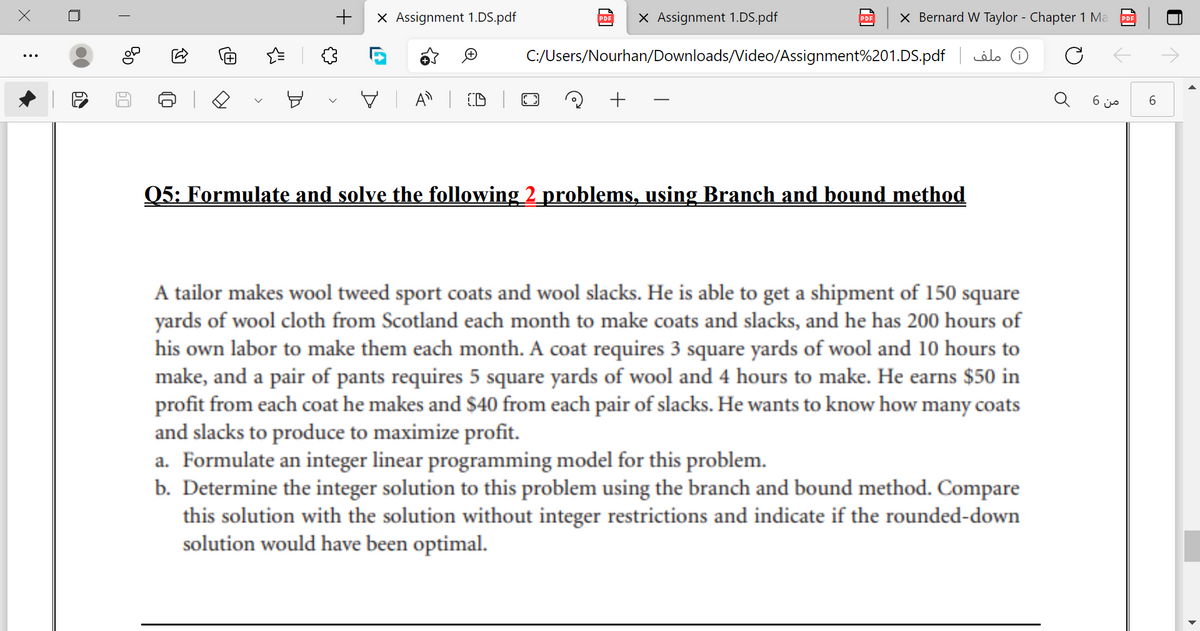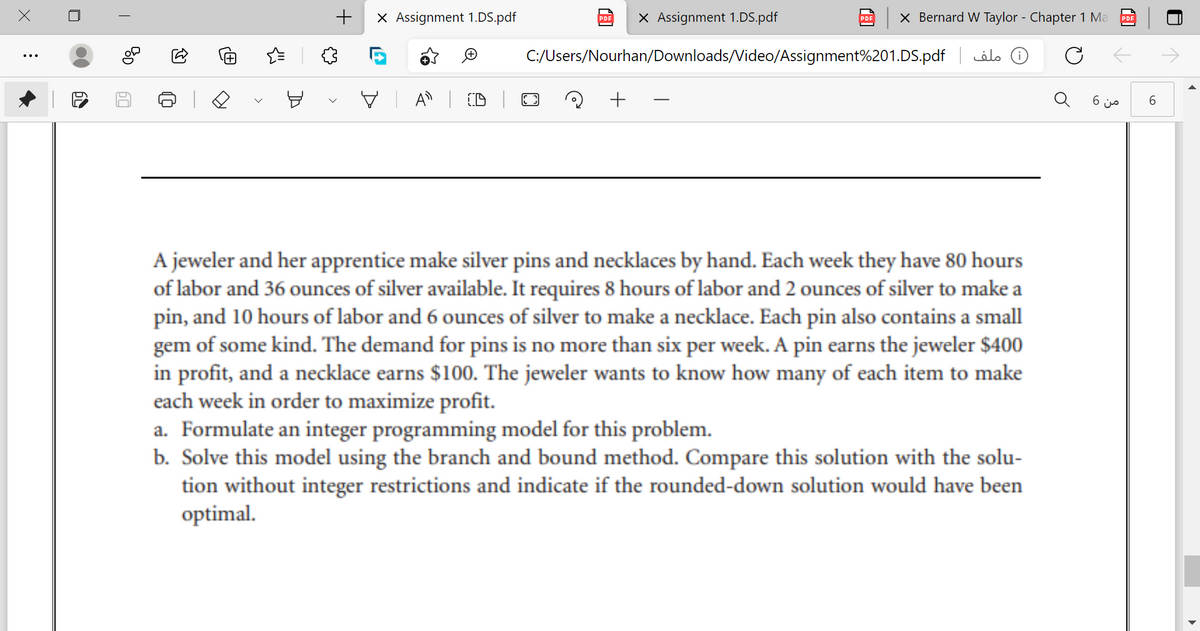A tailor makes wool tweed sport coats and wool slacks. He is able to get a shipment of 150 square yards of wool cloth from Scotland each month to make coats and slacks, and he has 200 hours of his own labor to make them each month. A coat requires 3 square yards of wool and 10 hours to make, and a pair of pants requires 5 square yards of wool and 4 hours to make. He earns $50 in profit from each coat he makes and $40 from each pair of slacks. He wants to know how many coats and slacks to produce to maximize profit. a. Formulate an integer linear programming model for this problem. b. Determine the integer solution to this problem using the branch and bound method. Compare this solution with the solution without integer restrictions and indicate if the rounded-down solution would have been optimal.
A tailor makes wool tweed sport coats and wool slacks. He is able to get a shipment of 150 square yards of wool cloth from Scotland each month to make coats and slacks, and he has 200 hours of his own labor to make them each month. A coat requires 3 square yards of wool and 10 hours to make, and a pair of pants requires 5 square yards of wool and 4 hours to make. He earns $50 in profit from each coat he makes and $40 from each pair of slacks. He wants to know how many coats and slacks to produce to maximize profit. a. Formulate an integer linear programming model for this problem. b. Determine the integer solution to this problem using the branch and bound method. Compare this solution with the solution without integer restrictions and indicate if the rounded-down solution would have been optimal.
Linear Algebra: A Modern Introduction
4th Edition
ISBN:9781285463247
Author:David Poole
Publisher:David Poole
Chapter2: Systems Of Linear Equations
Section2.4: Applications
Problem 6EQ: Redo Exercise 5, assuming that the house blend contains 300 grams of Colombian beans, 50 grams of...
Related questions
Question
Formulate and solve the following 2 problems, using Branch and bound method

Transcribed Image Text:+
X Assignment 1.DS.pdf
X Assignment 1.DS.pdf
X Bernard W Taylor - Chapter 1 Ma
PDE
PDF
C:/Users/Nourhan/Downloads/Video/Assignment%201.DS.pdf
)( ملف
V A | D
6 js
Q5: Formulate and solve the following 2_problems, using Branch and bound method
A tailor makes wool tweed sport coats and wool slacks. He is able to get a shipment of 150 square
yards of wool cloth from Scotland each month to make coats and slacks, and he has 200 hours of
his own labor to make them each month. A coat requires 3 square yards of wool and 10 hours to
make, and a pair of pants requires 5 square yards of wool and 4 hours to make. He earns $50 in
profit from each coat he makes and $40 from each pair of slacks. He wants to know how many coats
and slacks to produce to maximize profit.
a. Formulate an integer linear programming model for this problem.
b. Determine the integer solution to this problem using the branch and bound method. Compare
this solution with the solution without integer restrictions and indicate if the rounded-down
solution would have been optimal.

Transcribed Image Text:+
X Assignment 1.DS.pdf
X Assignment 1.DS.pdf
X Bernard W Taylor - Chapter 1 Ma
PDE
PDF
C:/Users/Nourhan/Downloads/Video/Assignment%201.DS.pdf
( ملف
V A D
6 js
A jeweler and her apprentice make silver pins and necklaces by hand. Each week they have 80 hours
of labor and 36 ounces of silver available. It requires 8 hours of labor and 2 ounces of silver to make a
pin, and 10 hours of labor and 6 ounces of silver to make a necklace. Each pin also contains a small
gem of some kind. The demand for pins is no more than six per week. A pin earns the jeweler $400
in profit, and a necklace earns $100. The jeweler wants to know how many of each item to make
each week in order to maximize profit.
a. Formulate an integer programming model for this problem.
b. Solve this model using the branch and bound method. Compare this solution with the solu-
tion without integer restrictions and indicate if the rounded-down solution would have been
optimal.
Expert Solution
This question has been solved!
Explore an expertly crafted, step-by-step solution for a thorough understanding of key concepts.
Step by step
Solved in 6 steps with 5 images

Recommended textbooks for you

Linear Algebra: A Modern Introduction
Algebra
ISBN:
9781285463247
Author:
David Poole
Publisher:
Cengage Learning

Algebra & Trigonometry with Analytic Geometry
Algebra
ISBN:
9781133382119
Author:
Swokowski
Publisher:
Cengage

Algebra for College Students
Algebra
ISBN:
9781285195780
Author:
Jerome E. Kaufmann, Karen L. Schwitters
Publisher:
Cengage Learning

Linear Algebra: A Modern Introduction
Algebra
ISBN:
9781285463247
Author:
David Poole
Publisher:
Cengage Learning

Algebra & Trigonometry with Analytic Geometry
Algebra
ISBN:
9781133382119
Author:
Swokowski
Publisher:
Cengage

Algebra for College Students
Algebra
ISBN:
9781285195780
Author:
Jerome E. Kaufmann, Karen L. Schwitters
Publisher:
Cengage Learning

College Algebra (MindTap Course List)
Algebra
ISBN:
9781305652231
Author:
R. David Gustafson, Jeff Hughes
Publisher:
Cengage Learning